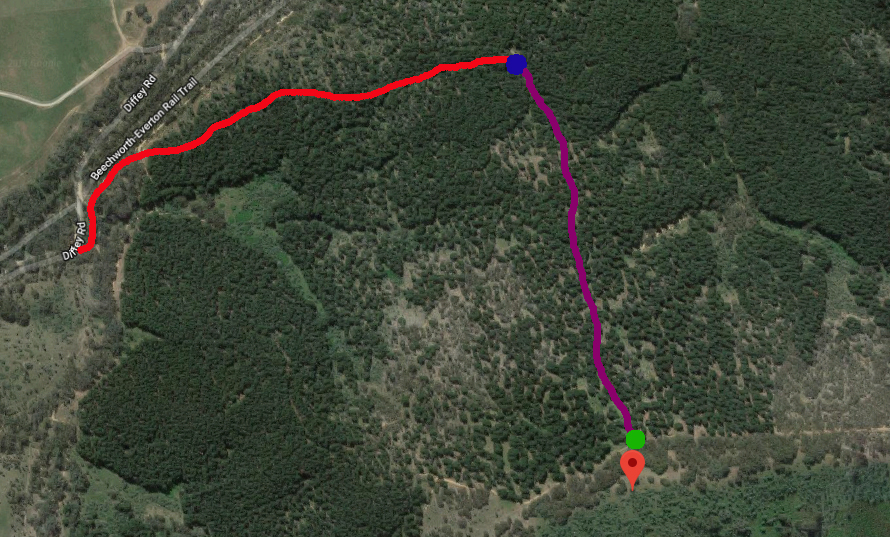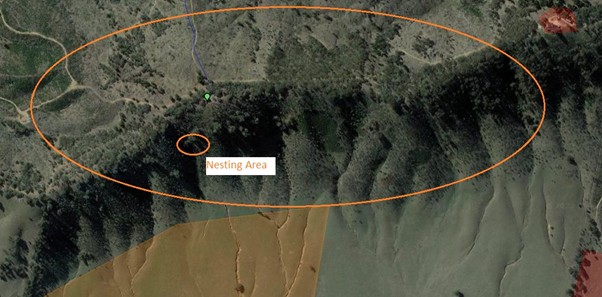Victoria > East Inland
Manny's
| Type | Inland ridge |
| Conditions | S-SSW |
| Height | 496m asl, landing 250m asl |
| Rating | PG2 / HG Supervised. PG2 require PG4/SO supervision. HG Sup require HG Int supervision. |
Landowners
Manny Dussin. His house is located at -36.4329,146.6303. The NEVHGC have had a long standing positive relationship with Manny. If you see him about stop and say hi, he's a lovely guy.
Contact/Responsible
NEVHGCDescription
Large inland ridge. Eagle Attacks – most wedgetail eagles in the area are friendly, however there is a grumpy eagle resident immediately in front of Manny’s launch who may attack paragliders. Please see Sitepage>Hazards for details.
To use Manny’s launch you will need to send two SMS text messages, as follows:
The launch and landing are in private property. Prior to using either, please send a text message to Manny (0427 271 318) detailing the number of pilots and vehicles prior to entering. Suggested messages are:
Hi Manny, we are [4] SAFA pilots in [2] vehicles wishing to use Manny’s PG launch and landing sites. Will that be OK, please?
Or:
Hi Manny, we are [2] SAFA pilots wishing to hike up to Manny’s launch to fly PG. Will that be OK, please?
Manny probably won’t reply but no reply implies it is OK.
Access is via private property from Diffey’s Road.
Please send a text message to Sam (0439 558 098) detailing the number of pilots and vehicles prior to entering and asking if it is OK to enter.
Suggested message is: Hi Sam, we are 4 SAFA pilots in 2 vehicles wishing to access Manny’s PG launch site from Diffey’s Road. Will that be OK, please?
Sam probably won’t reply but no reply implies it is OK.
Takeoff
A medium size slot between small trees and shrubs. Easy glide to landable paddocks below. The preferred landing paddock is marked in Green on the image below. Please use the one marked blue if there are young calves in the preferred paddock. Yes, these colours are the wrong way around – a legacy of the last calving.
Access:
Launch is accessible to 4WD vehicles only. The track is not suitable for 2WD and the upper section a challenge for low AWD - Subaru type vehicles. The access track begins to the right off Diffy Road, 50 meters before where the rail trail crosses Diffy Road. Bear left past the dam and at the junction carry straight on (leftish) to enter the gate marked ‘No Entry’, having first sent your text to Sam. Follow the track up the hill towards the new house. Use the track to the lower right past the sheds which keeps you clear of the house. Proceed with care and greet the owner if you see him. Follow the track around to the right and then up the hill. Do not park vehicles mid-climb as we have done in the past. From the corner, follow the steep track 200 meters SSE up the slope to the track junction at the ridge line taking care of the contour drains. Vehicles may be parked (tidily) in the lane way to the left of the new fence at the top of the track. Access to launch which is some 40m to the south is on foot through the old fence to its left. Note, the lower track section is marked in red and the upper track is marked in purple. The house site is near the blue dot.
An alternative track exists through the property to the west of Sam’s which has now been improved. Please do not use this as arrangements have not been made with the landowner who is planning to fence it all off.
Landing
Official landing zone is marked with Green box in image (Old 'Pines Launch' landing zone). Blue area also a suitable landing option but Green area preferred. Vehicles can be left at the gate (beside the shed) on the green box landing area. Access to the turnoff for the track marked with red line and dot on same image.
Flight
Controlled airspace exists over launch C LL 4500. You must check current Albury VTC or Melbourne VNC for any changes.
Hazards / Comments
Be aware that the site is a tree slot therefore it is advisable to not launch in cross wind conditions. Also be aware of strong SW winds that could cause rotor from the bare hills to the SW of Launch. Also, please drive slowly around farm houses in the area, the area can be quite dusty and minimizing speed will minimize dust for the local land owners. Also, please leave all gates as you find them.
Lastly, be aware of Eagle attacks to the right of launch, especially in Spring. The flats out the front often work and if an Eagle is in the vicinity then moving away from the hill may be preferable to eagle strike.
Manny's Eagles
There are many Wedge-tailed eagles resident in the area. The great majority are friendly, will join you in a thermal or show you where the lift is better. However, a number of eagles are territorially aggressive, will attempt to warn you out of their area and may attack your wing if you do not leave. There have been a number of such incidents in recent years in the vicinity of Manny’s launch.
The eagle’s nest is in the large eucalypts immediately in front and below launch and the eagle has been known to patrol anywhere along the ridge both to the right and left of launch though rarely as far as the first residence. His patrol area is outlined in brown. There are other families of eagles on the ridge but it seems only this one is aggressive.
Attacks may occur at any time of year but are more frequent when the eaglets are being raised between October and March. The eagle’s job is to drive us away from his nest. If you do as he asks he probably won’t attack. Attacks may occur at any height but most usually after launch and once you have established a ridge soaring pattern. If flying here it is advised that you keep a vigilant look out. If you see the eagle rise from his nest and begin to approach you, immediately turn away from him, his nesting area and the terrain.
He may pursue you, if so he will climb above and then attack your wing from behind usually going for your wing tips. You may hear him calling as he approaches – he sounds similar to a cat mewing. You may not hear that in which case the first you will know is when you feel a tug on the wing similar to a sharp thermal bubble. If you look up you will probably then see him fly past as he circles for another go. You can reduce the chance of him making contact with the wing by making steep wingovers. As he approaches from behind, pull a deep wing over on the side of his attack. He will not always be able to manoeuvre and follow the wing down and will have to circle back for another try. Keep doing that while at the same time leaving the terrain as fast as you can. As you get further out and away from his nest, it is probable that he will break off.
Damage to the wings is caused by the eagle’s three talons piercing the material and potentially tearing a section away. Damage can be anything from light nicks to the wing being a complete write off. We have no record of a wing being so damaged that it cannot be flown to a safe landing.


